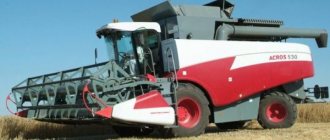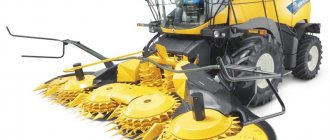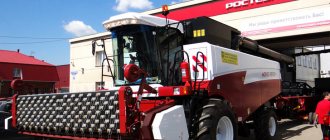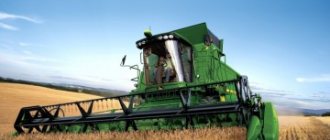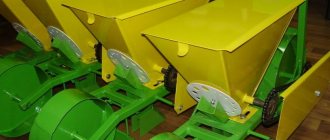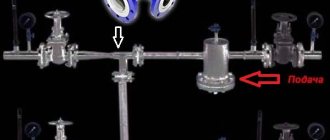Combine Harvester Adjustments
In this article, we will answer the following questions:
- How to minimize losses when harvesting crops?
- What should be the optimal speed of the combine, taking into account the yield and grain moisture?
With small losses, as well as excellent quality, grain crops are harvested in a short time, namely, when the ears ripen to a state of ripeness or the beginning of overripeness.
There are two ways to harvest grain crops:
- Separate (in 2 phases). Strada with laying in windrows, then their selection, and only then threshing of the windrows.
- Direct cleaning (in one phase)
What is the best combination method?
If the weather before the grain harvest is unfavorable, then it is preferable to use direct combining. The fact is that the stem will dry much faster than if the stems are in rolls. Cereals that will be used for sowing material, as well as malting barley, are best threshed in a direct way.
As for separate harvesting, it will be relevant in conditions of large weediness of the field or with uneven maturation of the crop or strong development of stubble crops. It is also important to emphasize that an earlier start of harvesting, protracted periods, as well as the use of combines in two-phase harvesting will necessarily lead not only to a decrease in the quality of the crop, but also to large financial costs.
In the conditions of a separate harvesting process in 2 phases, the grain must be mowed into a swath when the crop has reached milky-wax ripeness.
At what optimal time should grain be threshed?
In order for grain threshing to take place in the optimal mode, the following indicators should be adhered to:
- before harvesting, the ears should be free of dew. Grain moisture should not exceed 14 percent;
- The harvesting campaign must be organized in such a way that the grain does not have to be dried afterwards. After all, the cost of drying usually exceeds the cost of using combines in poor harvest conditions;
- cereals should be of normal size, habitual color, and their surface should be slightly wrinkled;
- the core of the grain is hard to the touch, but crackling when biting;
- yellow straw with a transition to a dark gray color;
- rye straw should be crushed into small pieces when the header is rotated;
- stem nodes should be firm and brown in color;
- wheat stalks should break easily at the base;
- cereals are easily wiped out of the ears, but they are firmly seated so that they do not fall out without extraneous effort;
- at the top of the barley the straw breaks easily.
If you choose the right time for harvesting, grain yield losses will be minimized.
How to harvest certain types of crops
Below we will consider the features of the harvest of the most common crops:
- spring barley is an ideal crop for harvesting with a combine harvester. Moreover, the timing of the harvest will allow you to fully use the potential of combines. Barley for the production of beer must be mature. In other words, its cleaning begins when broken ears begin to appear. At the same time, you need to clean in a gentle mode;
- rye is difficult to harvest on a combine. To determine the timing of the harvest, it is necessary to correctly calculate the maturity of the straw. If there is a lot of moisture on a long stalk of straw, you need to properly adjust the header of the combine. If the straw has an immature long, wet stem, then it will wind around the drum and thereby interfere with threshing. Under favorable conditions (good weather, and no lodging), it can be removed even when the culture is overripe;
- oats are a crop that is difficult to harvest because it has a short harvest time, a tendency to carrion, and uneven maturation of the straw. It may happen that in conditions of different-ripening parts of crops, it will be necessary to carry out differentiated threshing;
- winter barley is also a hard-to-harvest crop. With uneven maturation, this crop has a short harvesting period, as well as a high tendency to lodging. Also, when working with a combine, the ears break. Harvesting should begin when the ears are just beginning to break, and the awns are already mature, but the break occurs only during threshing;
- triticale for combine harvesting is an unsuitable crop. If stem lodging is observed, prompt harvesting is needed;
- wheat for 1-phase harvesting is considered a convenient crop. Its uniform ripening is better than that of the same barley. However, it is more convenient to thresh wheat than barley.
How to estimate grain losses
The loss of grain during the harvesting campaign is distinguished by:
- Until the harvest.
- During the threshing.
- At the straw walker.
- During cleaning.
In the course of a grain harvest, the shortfall can be estimated by the volume of ears that remained intact behind the combine. Grains that spill onto the ground behind the combine are the loss of the straw walker. This problem can be solved by increasing the speed of the drum, but at the same time reducing the distance between the concave and the drum. In this way, losses in grain can be reduced, but there will be more crushed straw. In the future, there will be quite a lot of chopped straw on the straw walker.
Throughput also affects the overall loss of cereals. If it is increased through the speed of the combine, then in proportion to the speed of movement, the volume of grain loss will increase. This will especially happen because of the straw walker.
If the percentage of the mass of straw to the mass of grain dominates, then the speed of the combine must be reduced.
Also, the width of the harvester of agricultural machinery affects the limiting ability to pass straw.
Under conditions of average stalking, with a combine speed of 4 km per hour, regardless of the size of the header, grain loss will be about 1.5 percent. Recall that with an increase in the degree of grain moisture and straw yield, the speed of the combine should be reduced. Otherwise, grain losses will increase.
Properly setting up a combine harvester
One of the important parameters for setting up a grain harvester is the speed of its movement across the field. The speed of the combine reel should not be such as to lead to a broach or its premature impact.
Combine harvester speed should be adjusted according to the following criteria:
- deadness of cereals. In such fields, the speed of the combine may not exceed 1 km per hour;
- moisture and ripeness of grain;
- header width;
- grain sowing density per square meter;
- agricultural machinery capacity;
- infestation of the field with weeds;
- crop yield.
According to the observations of machine operators and agronomists, the optimal speed of modern combines, which have been harvesting grain for a long time, is 6.5-8 km/h.
But the speed of the combine, as well as its units, is adjusted depending on the increase in the moisture content of the grain. This will allow you to achieve the optimal performance value with minimal grain loss. To do this, it is necessary to measure the drum revolutions and the speed of the combine every 2-4 hours.
Setting the speed of the combine drum
For wheat, the following settings are relevant:
- rotation of the drum within 700-800 rpm;
- concave with a gap at the exit of not more than 3-6 mm;
- wind within 650-750 rpm;
- with a yield of 30 c/ha, the speed of the combine is within 4.5-6.4 km/h.
For barley, the following settings are relevant:
- rotation of the drum within 650-750 rpm;
- concave with a gap at the exit of not more than 3-6 mm;
- wind within 550-700 rpm;
- with a yield of 30 c/ha, the speed of the combine is within 3-4.5 km/h.
- the sieve gap should have the following parameters: lower (7-12 mm), upper (10-12 mm), extension (10-12 mm).
You need to know these nuances for setting up a combine harvester
At first, be sure to monitor the quality of threshing, both behind the combine and in the bunker. It is impossible to allow shredded, spikelets and chaff. Based on these factors, recommendations for setting up a combine harvester will be as follows:
- Reduce the wind if there are small grains behind the agricultural machine.
- With clogged grain in the bunker, you need to increase the speed to the wind or slightly open the extension and sieves.
- Increase the speed of the drum or, as an option, tighten the concave, provided that underthreshing is observed in the straw.
- If the grain is crushed, reduce the speed of the drums, increase the clearance of the deck and slightly open the lower sieve. It is also worth taking into account that the grain can be crushed due to worn feeder house conveyors and augers.
- Reduce the wind or slightly open the extension and sieve if there is a loss of grain in the chaff.
- The threshing of grain will be the better, the shorter the distance, as well as the greater the frequency of revolutions of the drum. However, this increases grain crushing. Compromise: drum speed 25-33 m/s.
- The drum speed must be high, and the distance between the concave and the drum is adjusted depending on the degree of straw moisture.
- The average cutting height of the stem is 10-20 cm. With large volumes and accelerated harvesting of grain, cuts can be made higher, but not more than 20-30 cm.
- Wide-cut headers will be appropriate for large areas. The soil must also be taken into account.
- Reel speed needs to be adjusted. The crop must be actively fed into the header. The optimal plank height is 2/3 of the stem height.
The device and adjustment of the main components of the combine
The reaping part of the combine consists of a header, a spacer and a feeder house. The header of the combine is designed for cutting (with direct combining) or picking up (with separate harvesting) and feeding the grain mass into the thresher of the combine. The harvester includes (fig. 8.4.) the body 4,
cutting unit
13,
reel
1
, auger
11
, balancing mechanism and drive mechanisms
7
.
Pivot shoes are pivotally mounted in the lower part of the body 10.
They can be in four different positions, providing a cutting height of stems in the range of 50–185 mm. The body of the harvester is connected to the spacer at three points, due to which there is the possibility of longitudinal and transverse copying of the field relief. Dividers are installed on the sidewalls of the header housing.
The cutting device of the combine is similar in design and principle of operation to the mower. It consists of a knife and a finger bar, which is fixed on the front bar of the harvester. The cutting elements of knives can be with double fingers without inserts, with open type fingers and with steel inserts. The blade is reciprocated by a swash plate mechanism operating in an oil bath.
| 1 13 12 11 10 9 |
Rice. 8.4. Harvesting part of the Don combine:
1 - reel; 2 - eccentric device; 3 - reel support; 4 – harvester body; 5 – housing of the inclined chamber; 6 - snake; 7 - drive pulley; 8 - conveyor of the inclined chamber; 9 – spacer beater; 10 - copying shoe; 11 - auger; 12 - finger screw mechanism; 13 - cutting device
To ensure normal operation of the cutting unit, the toes of the segments should be in contact with the liners in the front part, and have a gap of 0.3–1.5 mm in the rear part. The gaps are set with shims. The gaps between clamps and segments should be no more than 0.7 mm.
Reel
serves to bring the stalks of the harvested crop to the cutting unit and supply the cut plants to the platform and to the harvester auger. It consists of a central tube with flanges to which discs with beams are attached. Pipes with spring rakes are hinged at the ends of the beams. The reel is mounted on two supports located on the left and right sidewalls of the harvester and connected with synchronously acting hydraulic cylinders for raising and lowering the reel. The eccentric mechanism of the reel provides a given inclination of the rakes when the shaft rotates. Depending on the working conditions, the spring tines can be tilted from 15° forward (upright crop) to 300 back (lay down crop).
There is a mechanism for shifting the reel shaft relative to the cutting unit. The reel drive is a V-belt variator, a double-circuit chain transmission and a safety friction clutch mounted on the left axle.
In height, the reel should be located so that its slats, at the entrance to the grain stand, strike at the center of gravity of the stalk at a distance of 1/3 of the length of the stalk from the top of the ear. Proper horizontal alignment of the reel is essential. Stalks caught in the plank must be supported until they are cut by the cutter bar. Stalks slipping out from under the bar is an indication that the reel is not positioned correctly. The reel speed is chosen such that the circumferential speed of the bars is 1.2–1.8 times higher than the forward speed of the combine. As the harvester speed increases, this ratio should decrease.
The auger
is designed to transport the cut stem mass to the center of the header and feed it into the spacer.
It consists (Fig. 8.5.) of a cylindrical body 5
, on the surface of which spiral tapes
6, 16
of the right and left winding are welded.
In the center of the auger against the window in the header housing there is a four-row finger mechanism 7
, at the left end there is a reversible gearbox
3
with a drive sprocket
1
of the safety friction clutch.
The finger mechanism of the auger is a crankshaft 8
with fingers
10,
the ends of which go out through the eyes on the casing.
Rice. 8.5. Header auger:
1 - drive sprocket with safety clutch; 2 – auger lift adjusting screw; 3 - reversible gearbox; 4 - connecting sleeve; 5 - cylindrical body; 6, 16 - spiral tapes of the right and left winding; 7 - finger mechanism; 8 - axis; 9 - pin bushing; 10 - finger; 11 - quick-release pin; 12, 17 - plates; 13 - bushing; 14 - adjusting lever; 15 - hole for lubrication; 18 - nut
When the auger rotates, the fingers entrained by the eyes turn on a fixed crankshaft 8.
Due to the displacement of the crankshaft axis relative to the axis of rotation of the auger, the fingers protrude from the front side of the auger from the casing, and from the back side they sink into the eyes of the casing. Therefore, the finger mechanism actively captures the cut stems in the front of the auger, and as it moves towards the feeder house, the fingers drop the stems, sinking into the eyes of the casing.
The activity of capturing the stems with a finger mechanism is regulated by turning the crankshaft using a lever 14,
mounted on the right side of the header.
The gap between the auger spirals and the bottom of the header can be changed depending on the working conditions within 6–35 mm (with the optimal value for average harvesting conditions being 10–15 mm). Reversible gearbox 3,
installed in the screw drive mechanism, is designed to transfer rotation to the screw in the forward (working) and reverse (when clogged) directions. The gearbox is controlled by a hydraulic system.
Balancing mechanism
header body consists of two lever-spring systems located on the header body on both sides of the spacer. When adjusting, the springs of both blocks are tensioned so that the pressure force at the ends of the front bar near the dividers is 300–400 N.
spacer
Serves as an intermediate link between header and feeder house.
It consists of a body and a beater 9
(Fig. 8.4.), Equipped with a finger eccentric mechanism, similar to the finger screw mechanism. The gap between the fingers and the bottom of the spacer is adjusted by turning the handle. Under average harvesting conditions, this gap should be in the range of 28–35 mm.
feeder house
consists (Fig. 8.6.) of the housing, the upper 13
leading
driven
.
The lower shaft
19
is spring-loaded in the longitudinal and transverse directions, which, in combination with the skids that support the conveyor chains, creates favorable conditions for a uniform supply of grain mass to the thresher. There should be a gap of 5–10 mm between the conveyor slats and the bottom of the feeder house.
thresher
harvester "Don-1500" is made according to the classical scheme, but without a receiving beater.
It consists (Fig. 8.7.) of a threshing drum 17 with a single-section lattice concave - a deck 19,
a six-blade baffle beater, a straw walker and a windscreen cleaning.
Between the floating conveyor and the concave of the threshing apparatus there is a stone trap, which is formed by a front shield with a hinged lid and a rear shield. The process of stone trapping is based on the shock reflection of stones and other objects from the fast-moving whips of the threshing drum. Threshing in the threshing apparatus occurs as a result of repeated blows to the stems and the ear while the mass is dragged through the wedge-shaped decreasing threshing gap between the drum and the concave.
Rice. 8.6. Tilt camera:
1 - spring of the lower shaft of the floating conveyor; 2 - adjusting washer; 3 - chain-slat conveyor; 4, 8 - adjusting nuts; 5 - bolt; 6 - hook; 7 - tension screw; 9 - lever; 10 - adjusting bolt; 11 - bracket; 12 - nut; 13 - drive shaft; 14 - locking wire; 15 - connecting link; 16 - transition link; I7 - safety stop hook; 18 - coupling screw; 19 - lower shaft
Threshing drum
is a ten-bladed rotor with a diameter of 800 mm. The drum is driven through a V-belt variator. It has discs with picks on which whips are attached. The base of the whips is rotated 7° in the direction of rotation.
The concave (fig. 8.7.) consists of a lattice deck and an entrance shield fixed on it, a rotary finger lattice 16
and apron
18.
The drum concave wrapping angle is 130°.
The deck frame is formed by two symmetrical cheeks, transverse planks and ribs that pass through elongated holes in the planks. The separating grid is formed by rods inserted on both sides of the deck. Through it, grain and small fractions of the threshed heap are released. The concave is suspended on four hangers 15
and
27.
The concave suspension and adjustment mechanism is designed to change the value of the threshing gap at the inlet and outlet, to protect the concave from breakage during overloads due to elastic deformations of the links. Consists of two two-arm levers 13,
torsion shaft
12,
suspensions
15, 27, 29
and two-arm levers
28.
The latter are mounted on axles mounted on the sidewalls of the thresher.
The suspensions are connected to the deck by axes 24
installed in the bushings of the lugs of the cheeks of the deck, and fixed in the grooves of the sidewalls of the thresher with eccentric washers
22.
When the suspension is rotated, the washers interact with the hooks
21
and the protrusion 23
.
Fig.8.7. Threshing machine
1.6 - dogs; 2, 9 - ratchet wheels; 3 – concave release pedal; 4 – deck control lever; 5 - limbus; 7 - shaft; 8 - asterisk; 10 - chain; 11 - tubular shaft; 12 - torsion shaft; 13, 28 - two-arm levers; 14 - shaft supports; 15, 27, 29 - pendants; 16 - finger grating; 17 - drum; 18 - apron; 19 - deck; 20 - coupling nut; 21 - hook; 22 - eccentric washer; 23 - ledge; 24 - axis; 25 – suspension head; 36 - shield; 30 - lever; A - clearance at the inlet; B - outlet clearance
Lever arm 4
adjustment of the threshing gap through the chain
10
and the ratchet mechanism for lifting and resetting the concave is connected to the lever
30,
through the tubular shaft
11 -
with suspensions.
The suspension torsion shaft is rigidly connected to the same shaft. 3
is also connected to the ratchet mechanism . It is a six-blade drum mounted on the main counter-drive shaft with blades bent back with respect to the direction of rotation. The peripheral speed of the blades is 17.5 m/s.
On the right end of the beater shaft, pulleys are installed, different in diameter and number of streams, depending on the equipment of the combine with a pileer, a straw chopper or an adapter for harvesting corn.
Combine harvesters are equipped with one or two threshing machines. In a single-drum threshing device, a beater drum is used, in a double-drum - two beater drums ("Yenisei-1200", "Kedr-1200" or one pin and one beater drum ("Kedr-1200R", "Yenisei-1200R"). The former are used for harvesting grain crops mainly in conditions of high humidity, the second - for harvesting rice and other crops that are difficult to thresh.Pin threshers are attached to the bars of the pin threshing drum, its concave is also equipped with pins, which are arranged in rows so that each pin of the drum passes between the pins of the concave. , than beater, thresh wet bread, but crushes straw more.
Straw walker
is designed to extract grain from the straw that has passed through the threshing device as a result of counter-strokes of the keys on the mass falling on them. The combine straw walker with a threshing width of 1500 mm consists of five keys. The key is a chute inclined towards the transport board, closed from above with a louvered unregulated grille. The upper part of the keys is made in the form of seven cascades, which contributes to better shaking the grain out of the straw. The keys are mounted on disposable lubrication bearings on the crankshafts.
cleaning
combine includes (Fig. 8.8.) transport board
5,
fan
8,
two louvered sieves
3
and
9,
upper sieve extension
2
, augers
10
and
13,
elevators and drive mechanisms.
During operation, the transport board, due to vibrations, transports to the upper sieve 3
heap falling on her.
At the end of the transport board there is a finger grate 4,
which allocates the grain fraction to the beginning of the upper sieve, and directs the straw particles to a less loaded section of the separating surface.
The separation of grain from the heap takes place on oscillating louvered sieves, blown by a directed air flow from the fan 8.
2
with two adjustable louvered surfaces
is installed Descents from the extension of the upper sieve and light particles of the heap are fed into the stacker. The cleaned grain is fed into the grain auger 10
and then fed into the bunker by the grain elevator.
The mass retained by the extension falls into the return auger 13,
and then the elevator
14
directs the heap with spikelets to the autonomous re-threshing device
15.
| Grain heap Straw impurities Under-threshed spikelets Grain and threshed spikelets Pure grain Air |
Rice. 8.8. Grain heap separator (cleaning) and its operation scheme:
1 - removable tray; 2 - swivel extension: 3 - upper sieve; 4 - finger grating; 5 - transport board; 6 - front seal; 7 - drive mechanism; 8 – fan; 9 - lower sieve; 10 - grain auger: 11 - pitched board; 12 - body; 13 - return auger; 14 - return elevator; 15 - re-threshing device; 16 - distribution auger
The main part of the pre-threshing device is the rotor blades.
The blades have wavy depressions that interact with the protrusions on the deck and actively thresh the mass. When harvesting easily damaged crops, a smooth shield is mounted instead of a deck. The re-threshed heap again goes for cleaning.
Lecture 12


